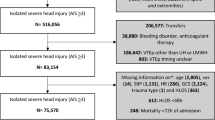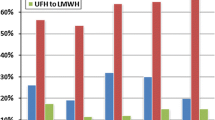Abstract
Background
The literature on upper extremity deep venous thrombosis (UEDVT) is not as abundant as that on lower extremities. This study aimed to identify the risk factors for UEDVT, associated mortality and morbidity in trauma patients and the impact of pharmacological prophylaxis therein.
Methods
A 3-year retrospective review of patients admitted to a Level 1 trauma center was conducted. Patients aged 18 years or older who had experienced a traumatic event and had undergone an upper extremity ultrasound (UEUS) were included in the study. Multiple logistic regression was used to identify independent risk factors that contributed to UEDVT.
Results
A total of 6,607 patients were admitted due to traumatic injuries during the study period, of whom 5.6% (373) had at least one UEUS during their hospitalization. Fifty-six (15%) were diagnosed with an UEDVT, as well as three non-fatal pulmonary emboli (PE) and four (7.1%) deaths, p = 0.03. Pharmacological prophylaxis with low-molecular-weight heparin (LMWH) or unfractionated heparin showed a protective effect against UEDVT; among the patients positive for UEDVT, 14 of 186 patients (7.5%) received LMWH, while 42 of 195 (21.5%) did not receive LMWH (p < 0.001). Multiple logistic regression revealed that the presence of upper extremity fractures, peripherally inserted central catheter (PICC) lines, and traumatic brain injury (TBI) were independent risk factors for UEDVT.
Conclusions
UEDVT are associated with a higher mortality. The presence of upper extremity fractures, PICC lines, and TBI were independent risk factors for UEDVTs. Further, pharmacological prophylaxis reduces the risk of UEDVT.
Similar content being viewed by others
References
Gando S, Kameue T et al (1997) Participation of tissue factor and thrombin in posttraumatic systemic inflammatory syndrome. Crit Care Med 25:1820–1826
Gando S, Nanzaki S et al (1999) Systemic activation of tissue-factor dependent coagulation pathway in evolving acute respiratory distress syndrome in patients with trauma and sepsis. J Trauma 47:719–723
Geerts W, Code K (1994) A prospective study of venous thromboembolism after major trauma. N Engl J Med 331:1601–1606
Shackford S, Davis J, Hollingsworth-Fridlund P et al (1990) Venous thromboembolism in patients with major trauma. Am J Surg 159:365–369
Constans J, Salmi L et al (2008) A clinical prediction score for upper extremity deep venous thrombosis. Thromb Haemost 99:202–207
Malinoski D, Ewing T et al (2013) Which central venous catheters have the highest rate of catheter-associated deep venous thrombosis: a prospective analysis of 2128 catheter days in the surgical intensive care unit. J Trauma 74:454–452
Hingorani A, Ascher E et al (2005) Risk factors for mortality in patients with upper extremity and internal jugular deep venous thrombosis. J Vasc Surg 41:476–478
Prandoni P, Polistena P et al (1997) Upper-extremity deep vein thrombosis. Risk factors, diagnosis, and complications. Arch Intern Med 157:57–62
Lobo B, Vaidean G et al (2009) Risk of venous thromboembolism in hospitalized patients with peripherally inserted central catheters. J Hospital Med: Off Publ Soc Hospital Med 4:417–422
Marnejon T, Angelo D et al (2012) Risk factors for upper extremity venous thrombosis associated with peripherally inserted central venous catheters. J Vascular Access 13:231–238
Greene MT, Flanders SA et al (2015) The association between PICC use and venous thromboembolism in upper and lower extremities. Am. J. Med 128:986-e1
Clinical guidelines on the identification, evaluation, and treatment of overweight and obesity in adults: executive summary. Expert Panel on the Identification, Evaluation, and Treatment of Overweight in Adults. (1998) Am. J. Clin. Nutr 68:899-917
Bates S, Jaeschke R et al (2012) Diagnosis of DVT: antithrombotic therapy and prevention of thrombosis, 9th ed: American college of chest physicians evidence-based clinical practice guidelines. Chest 141:e351S-418S
Ekeh A, Dominguez K et al (2010) Incidence and risk factors for deep venous thrombosis after moderate and severe brain injury. J Trauma 68:912–915
Freeark R, Boswick J et al (1967) Posttraumatic venous thrombosis. Arch Surg 95:567–575
Schreiber M, Differding J et al (2005) Hypercoagulability is most prevalent early after injury and in female patients. J Trauma 58:475–471
Sawyer G, Hayda R (2011) Upper-extremity deep venous thrombosis following humeral shaft fracture. Orthopedics 34:141
Peivandi MT, Nazemian Z (2011) Clavicular fracture and upper-extremity deep venous thrombosis. Orthopedics 34:227
Adla DN, Ali A et al (2004) AUpper-extremity deep-vein thrombosis following a clavicular fracture. Eur J Orthop Surg Traumatol 14:177–179
Van Gent J, Bandle J et al (2014) Isolated traumatic brain injury and venous thromboembolism. J Trauma Acute Care Surg 77:238–242
Geerts WH, Jay RM et al (1996) A comparison of low-dose heparin with low-molecular-weight heparin as prophylaxis against venous thromboembolism after major trauma. N Engl J Med 335:701–707
Velmahos GC, Kern J et al (2000) Prevention of venous thromboembolism after injury: an evidence-based report–part I: analysis of risk factors and evaluation of the role of vena caval filters. J Trauma 49:132–138
Knudson MM, Morabito D et al (1996) Use of low molecular weight heparin in preventing thromboembolism in trauma patients. J Trauma 41:446–459
Kwiatt M, Patel M et al (2012) Is low-molecular-weight heparin safe for venous thromboembolism prophylaxis in patients with traumatic brain injury? a western trauma association multicenter study. J Trauma 73:625–628
Norwood S, McAuley C et al (2002) Prospective evaluation of the safety of enoxaparin prophylaxis for venous thromboembolism in patients with intracranial hemorrhagic injuries. Arch Surg 137:696–692
Phelan H, Wolf S, Norwood S (2012) A randomized, double-blinded, placebo-controlled pilot trial of anticoagulation in low-risk traumatic brain injury: the delayed versus early enoxaparin prophylaxis I (DEEP I) study. J Trauma Acute Care Surg 73:1434–1441
Byrne J, Mason S, Gomez D et al (2016) Timing of pharmacologic venous thromboembolism prophylaxis in severe traumatic brain injury: a propensity-matched cohort study. J Am Coll Surg 223:621–631
Kommareddy A, Zaroukian M, Hassouna H (2002) Upper extremity deep venous thrombosis. Seminars Thrombosis 28:89–99
Lindblad B, Tengborn L, Bergqvist D (1988) Deep vein thrombosis of the axillary-subclavian veins: epidemiologic data, effects of different types of treatment and late sequelae. Eur J Vasc Surg 2:161–165
Joffe H, Kucher N, Tapson V et al (2004) Upper-extremity deep vein thrombosis: a prospective registry of 592 patients. Circulation 110:1605–1611
Hingorani A, Ascher E et al (1997) Upper extremity deep venous thrombosis and its impact on morbidity and mortality rates in a hospital-based population. J Vasc Surg 26:853–860
Hingorani A, Ascher E et al (2006) Morbidity and mortality associated with brachial vein thrombosis. Ann Vasc Surg 20:297–300
Bernardi E, Pesavento R et al (2006) Upper extremity deep venous thrombosis. Seminars Thrombosis 32:729–736
Perdue P, Watts D et al (1998) Differences in mortality between elderly and younger adult trauma patients: geriatric status increases risk of delayed death. J Trauma 45:805–805
Funding
None.
Author information
Authors and Affiliations
Corresponding author
Ethics declarations
Conflict of interest
The authors declare that they have no conflict of interest.
Informed consent
Hospital IRB.
Human and animal rights
There was direct contact with human subjects.
Additional information
Publisher's Note
Springer Nature remains neutral with regard to jurisdictional claims in published maps and institutional affiliations.
Rights and permissions
About this article
Cite this article
Walusimbi, M., Dossa, A.Y., Faryar, K. et al. Upper Extremity Deep Venous Thrombosis Risk Factors, Associated Morbidity and Mortality in Trauma Patients. World J Surg 46, 561–567 (2022). https://doi.org/10.1007/s00268-021-06383-y
Accepted:
Published:
Issue Date:
DOI: https://doi.org/10.1007/s00268-021-06383-y




